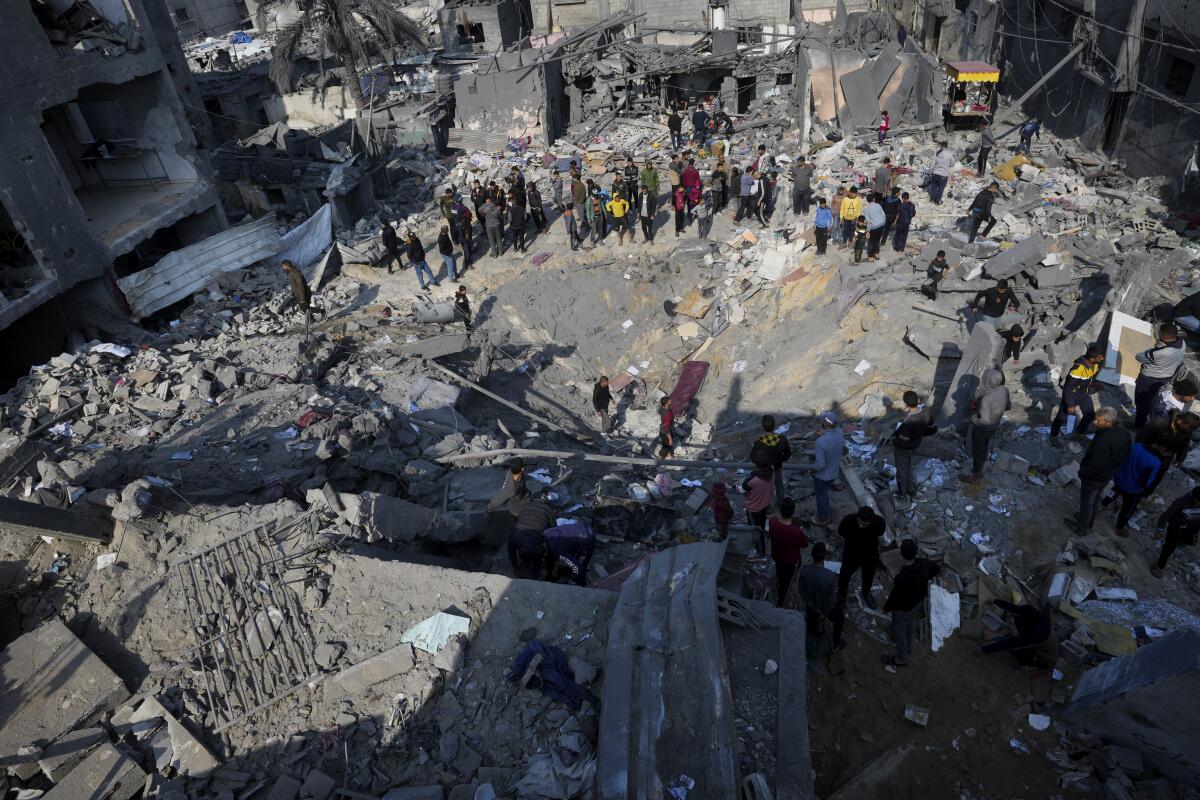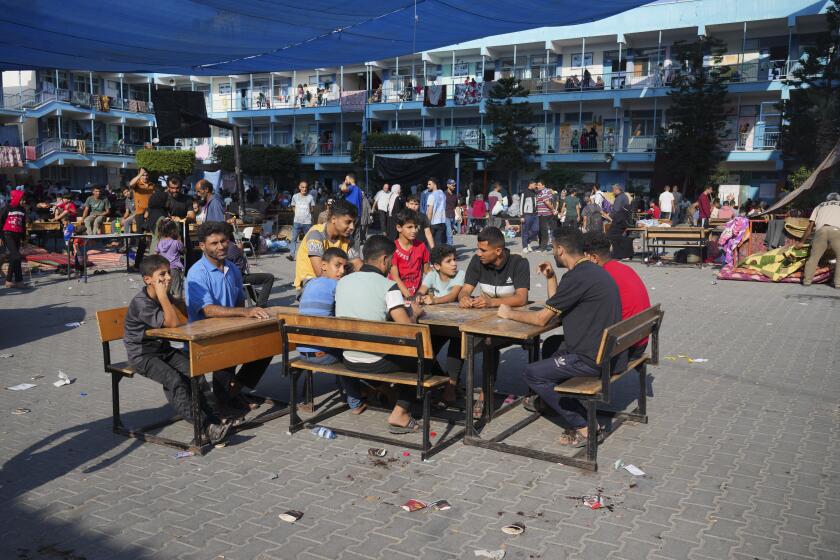Opinion: Israel’s Gaza strategy: Create facts on the ground that can’t be undone

- Share via
For decades, Israel has established “facts on the ground” to expand and entrench its control of the West Bank while defying international condemnation. Now, after the Oct. 7 Hamas attack, Israel is using the same strategy to achieve a new goal: the ethnic cleansing of Gaza.
By driving 2 million people from their homes, destroying critical infrastructure and bulldozing huge swaths of land entirely, the new facts on the ground Israel is creating will render Gaza uninhabitable by the time the guns fall silent, leaving no other option but mass displacement.
This approach — creating a reality that is virtually impossible to undo — was carried out by Israel in the 1970s in its rapid construction of settlements on Palestinian territory, which were widely recognized as illegal under international law. Even then, the strategy was not new. Years before the state of Israel was established in 1948, Zionist settlers flocked to Palestine and established small communes, or kibbutzim. Those settlements were instrumental in creating permanent, physical ties to the land.
With 20,000 dead in Israel’s bombing of Gaza, we feel compelled to prove our humanity. We have been denied agency as a people.
After Israel routed Arab armies in 1967, it seized control of vast regions from Egypt’s Sinai to Syria’s Golan Heights. In the years that followed, the international community coalesced around a recognition of the “inadmissibility of the acquisition of territory by war.” But Israel had other ideas. Although Egypt would later reclaim its land in a peace treaty, Israel embarked on a campaign to solidify its control of Palestine and the Syrian Golan by establishing new facts on the ground designed to make any negotiated settlement, any alternative to full Israeli sovereignty, impossible.
Between 1967 and 2017, Israel built more than 270 settlements and outposts throughout the West Bank and East Jerusalem, carving up land that would have served as the heart of a future Palestinian state into isolated islands. Today, more than 700,000 settlers now live in Israel’s continually expanding settlement network, ensuring that even if a miracle were achieved and a Palestinian state established along the 1967 borders, it would be hopelessly fragmented and effectively ungovernable.
This is the last colonial war in the modern age, fought to establish the hegemony and the absolute rights of one people over the other.
It did not matter that these settlements were unanimously considered by the international community as illegal under international law. Nor did it matter that even the U.S., Israel’s strongest supporter and benefactor, saw the expansionist settlement policy as an obstacle to peace. What mattered was that they were there — physical manifestations of Israeli settler-colonial expansion.
While Palestinians based their legitimate claims to the land on indigeneity, international law, even property deeds, Israel could point to the physical presence of Israeli settlements and settlers, shrug and say, “This is how it is now.” The international community, with no desire or ability to intervene, would effectively be forced to recognize Israel’s constructed reality retroactively.
Now, the Israeli government is in the process of once again unilaterally reconstructing reality on the ground, and in doing so, destroying all hopes for a peaceful future. This time, it is not pursuing expansionist goals through settlement construction, although resettling Gaza may very well be the plan in the long term. In attempting to annihilate Hamas, Israel is wiping Gaza as we know it off the map and rendering it unlivable for the 2.3 million Palestinians who call it home. This is not the unfortunate outcome of war, but a calculated strategy to achieve the goal of maximum land with minimum Palestinians — consider this the new facts on the ground.
The killing of journalists in the Gaza Strip is being normalized. President Biden and other world leaders must do more to protect them.
Even before Israel’s new onslaught, Gaza’s infrastructure was crippled by more than 16 years of a suffocating Israeli blockade. More than 85% of Gaza’s population of 2.3 million has been internally displaced, with no safe place within Gaza to flee. If Israel’s assault ended today, analysts estimate that more than 50% of housing in Gaza has already been severely damaged or destroyed. And Israel reportedly plans to flood Hamas’ tunnel network with seawater, which risks permanently polluting Gaza’s soil, contaminating its aquifers, and causing even more infrastructure collapse.
What will happen to the hundreds of thousands, if not millions, of Gazans after this destruction? Of course, Israel will not absorb the new wave of refugees it creates. Their fate will be placed in the hands of neighboring Arab states and the international donor community.
If Gazans are forced into Egypt or elsewhere, they will only add to the 75-year-old Palestinian refugee crisis.
Arab leaders, ranging from Egypt’s President Abdel Fattah Sisi to Jordan’s King Abdullah, have made it clear that the mass displacement of Palestinians from Gaza is a “red line.” Even the Biden administration, which has given Israel carte blanche to decimate Gaza, recently said Israel must work to avoid “significant further displacement” of Palestinian civilians. Yet, nobody is using leverage to dissuade Israel from creating the conditions that will make this supposedly unacceptable outcome inevitable.
Herein lies the menace of Israel’s “facts on the ground” strategy. Israeli leaders have over the years achieved their expansionist goals by gradually, but steadily, carrying out practices widely abhorred by the international community and illegal under international law. In the West Bank, ethnically cleansing all Palestinians in one fell swoop would probably trigger regional and maybe even international intervention, but taking the land incrementally by constructing settlements as stubborn facts on the ground could achieve the same end with less blowback.
Similarly, Israel does not need to kill Gaza’s entire population all at once. All it has to do is ensure the Gaza Strip is uninhabitable and the rest will follow. Israel can once again shrug its shoulders and point to the irreversible reality it created.
It does not have to end this way. The international community, with the U.S. at its helm, could discard its facade of helplessness and leverage their ample economic and diplomatic tools to make it clear to Israel that the mass displacement of Palestinians is unacceptable, that Gazans must be able to return to their homes. Without intervention now, Israel will march ahead, as it did in the West Bank, systematically destroying the viability of all alternative solutions and ensuring another Nakba of historic proportions.
Tariq Kenney-Shawa is the U.S. policy fellow at Al-Shabaka, a nonprofit think tank focusing on Palestinian issues.
More to Read
A cure for the common opinion
Get thought-provoking perspectives with our weekly newsletter.
You may occasionally receive promotional content from the Los Angeles Times.














